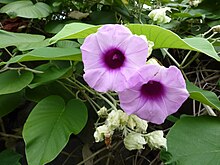Our website is made possible by displaying online advertisements to our visitors.
Please consider supporting us by disabling your ad blocker.
Argyreia nervosa
This article needs additional citations for verification. (April 2010) |
| Argyreia nervosa | |
|---|---|

| |
| Argyreia nervosa flowers (enlarge) | |
| Scientific classification | |
| Kingdom: | Plantae |
| Clade: | Tracheophytes |
| Clade: | Angiosperms |
| Clade: | Eudicots |
| Clade: | Asterids |
| Order: | Solanales |
| Family: | Convolvulaceae |
| Genus: | Argyreia |
| Species: | A. nervosa
|
| Binomial name | |
| Argyreia nervosa | |
| Synonyms[2] | |
|
Argyreia speciosa (L.f.) Sweet | |
Argyreia nervosa is a perennial climbing vine native to the Indian subcontinent and introduced to numerous areas worldwide, including Hawaii, Africa, and the Caribbean. Though it can be invasive, it is often prized for its aesthetic and medicinal value.[3] Common names include Hawaiian baby woodrose, adhoguda अधोगुडा or vidhara विधारा (Sanskrit), elephant creeper and woolly morning glory. Its seeds are known for their powerful entheogenic properties, greater or similar to those of Ipomoea species, with users reporting significant psychedelic and spiritual experiences.[4][5] The two botanical varieties are Argyreia nervosa var. nervosa described here, and Argyreia nervosa var. speciosa, the roots of which are used in Ayurvedic medicine.[3][6]
Argyreia nervosa contains various ergoline alkaloids such as ergine.[7] A study reported stereoisomers of ergine to be found in the seeds at a concentration of 0.325% of dry weight.[8] Two modern studies from a team of researchers also revealed lysergic acid,[9] methylergometrine (syn. lysergic acid butanolamide), methysergide, lysergylalanine, and suspected, unidentifed ergopeptines.[10] A study of the related Ipomoea tricolor showed that ergoline concentrations in the leaves are 12-fold lower than that of the seeds.[11]
- ^ Glossary Of Indian Medicinal Plants
- ^ "Argyreia nervosa". Germplasm Resources Information Network. Agricultural Research Service, United States Department of Agriculture. Retrieved 2010-11-10.
- ^ a b "Medicinal uses and biological activities of Argyreia speciosa Sweet (Hawaiian Baby Woodrose) — An Overview". Indian Journal of Natural Products and Resources: 286–291. September 2011.
- ^ E. Al-Assmar, Sami (1999). "The Seeds of the Hawaiian Baby Woodrose Are a Powerful Hallucinogen". Arch Intern Med. 159 (17): 2090. doi:10.1001/archinte.159.17.2090 (inactive 2024-11-13). PMID 10510998.
{{cite journal}}: CS1 maint: DOI inactive as of November 2024 (link) - ^ Paulke, Alexander; et al. (2015). "Studies on the alkaloid composition of the Hawaiian Baby Woodrose Argyreia nervosa, a common legal high". Forensic Science International. 249: 281–293. doi:10.1016/j.forsciint.2015.02.011. PMID 25747328.
- ^ The Ayurvedic Pharmacopoeia of India, part 1, vol. 5. Government of India, Ministry of Health and Family Welfare, Department of Ayush. http://www.ayurveda.hu/api/API-Vol-5.pdf
A. nervosa entry: page 16
“T.L.C. of methanolic extract of the roots on precoated silica gel G plate using methanol - chloroform (20 : 80) showed a blue fluorescent spot under UV (365nm) along with number of other spots of very weak intensity. Due to the presence of very negligible amount of alkaloids in the roots these could not be isolated.” (p. 17) - ^ Halpern, J.H. (2004). "Hallucinogens and dissociative agents naturally growing in the United States". Pharmacology & Therapeutics. 102 (2): 131–138. doi:10.1016/j.pharmthera.2004.03.003. PMID 15163594. S2CID 30734515.
Although LSD does not occur in nature, a close analogue, lysergic acid amide (LSA, ergine) is found in the seeds of Argyreia nervosa (Hawaiian baby woodrose)
- ^ Chao JM, Der Marderosian AH (1973). "Ergoline alkaloidal constituents of Hawaiian baby wood rose, Argyreia nervosa (Burmf) Bojer". J. Pharm. Sci. 62 (4): 588–91. doi:10.1002/jps.2600620409. PMID 4698977.
- ^ Paulke, Alexander; Kremer, Christian; Wunder, Cora; Wurglics, Mario; Schubert-Zsilavecz, Manfred; Toennes, Stefan W. (2014-09-01). "Identification of legal highs – Ergot alkaloid patterns in two Argyreia nervosa products". Forensic Science International. 242: 62–71. doi:10.1016/j.forsciint.2014.06.025. ISSN 0379-0738. PMID 25036782
“Additionally the presence of the ergot alkaloid diastereomers chanoclavine I and II was assumed in DF (cf. Fig. 6) together with traces of lysergic acid and the isobars lysergol, isolysergol, elymoclavine, molliclavine, setoclavine, or isosetoclavine.” (3.1. Mass spectrometry data, p. 65)
“Indications of traces of [M+H]+ = 255.15 0.01 corresponding to lysergol/isolysergol, elymoclavine, setoclavine/isosetoclavine or molliclavine as well as [M+H]+ = 269.13 0.01 corresponding to lysergic acid were only obtained in the DF extracts and the resolution and the quality of the EICs and product spectra was poor. Therefore, the presence of lysergol/isolysergol, elymoclavine, setoclavine/isosetoclavine, molliclavine or lysergic acid cannot be excluded, but proof cannot be provided and additional research will be necessary.” (3.1. Mass spectrometry data, pages 65 & 68){{cite journal}}: CS1 maint: postscript (link) - ^ Paulke, Alexander; et al. (2015). "Studies on the alkaloid composition of the Hawaiian Baby Woodrose Argyreia nervosa, a common legal high". Forensic Science International. 249: 281–293. doi:10.1016/j.forsciint.2015.02.011. PMID 25747328
“On the other hand, methylergometrine, methysergide, and lysergylalanine were detected, which have not yet been reported as compounds of Argyreia nervosa seeds. Furthermore, some high molecular weight ergot alkaloid derivatives and hydroxyalanine derived ergopeptide fragments could be observed at various retention times (c.f. chapter 3.1). Altogether, lysergylalanine, the high molecular weight ergot alkaloids and the hydroxyalanine derived ergopeptide fragments strongly suggest the presence of ergopeptides in Argyreia nervosa. However, due to the disadvantage of the applied APCI technique for peptide analysis (c.f. chapter 3.1) additional research (e.g. ESI-HRMS/MS) will be necessary to verify this assumption and to elucidate the structure of the ergopeptides.” (3. Results and discussion, p. 283){{cite journal}}: CS1 maint: postscript (link) - ^ Nowak, Julia; Woźniakiewicz, Michał; Klepacki, Piotr; Sowa, Anna; Kościelniak, Paweł (May 2016). "Identification and determination of ergot alkaloids in Morning Glory cultivars". Analytical and Bioanalytical Chemistry. 408 (12): 3093–3102. doi:10.1007/s00216-016-9322-5. ISSN 1618-2642. PMC 4830885. PMID 26873205"ergine and ergometrine concentration is 12-fold lower in plant samples than in seeds." Analysis of IP-HB2 young plants
{{cite journal}}: CS1 maint: postscript (link)
Previous Page Next Page


